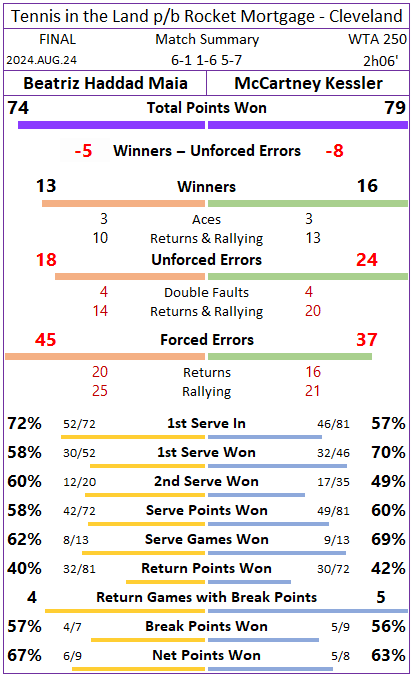Haddad Maia vs Kessler: Cleveland Final Analysis (WTA 250)
Serves to the forehand and long rallies played a big role in Kessler's first career WTA Tour title
Kessler arrived in Cleveland with 30 wins on the season and 3 titles at 3 different levels (WTA 125 Puerto Vallarta, ITF W100 Landisville and ITF W75 Rome), with her most recent triumph in Landisville just two weeks ago securing entry into the Top-100. The one thing now missing for Kessler were main draw WTA Tour wins. Her record stood at 1-6, with the single victory registered at the Australian Open round 1.
But everything changed in Cleveland as Kessler battled through 4 tough three-set matches, including comebacks from a set down against seeds Haddad Maia (1), Xinyu Wang (4) and Anastasia Potapova (5), and finally enjoyed her main Tour breakthrough with a handful of wins.
The early stages of the Cleveland final were dominated by Haddad Maia. Her lefty serve was giving Kessler all kinds of trouble, especially on backhand returns. In set 1, Haddad Maia landed 86% of 1st serves, 41% of which were not returned. When to Kessler’s backhand, the Brazilian won all 8 points.
Meanwhile, Kessler was averaging a double fault per serve game and coughed up another one on break point at the start of the second set.
Haddad Maia had all the momentum after winning 7 of the first 8 games, but she played a loose serve game at 6-1 1-0 and the match changed after that. The top seed’s slide began with 2 Deuce side double faults and a pair of AD side points lost after opting to serve to Kessler’s forehand (Haddad Maia went 10-for-10 in AD side points when serving to Kessler’s backhand during the first 2 sets!).
Levelling at 1-1 provided Kessler an enormous confidence boost. She took the second set with a 6-game run after finding an extra gear on her serve and groundstrokes (8-0 advantage in unreturned serves; 17-12 rallying edge in set 2).
Following two short and lopsided sets, the decider finally had both players performing at a similar level. Haddad Maia led 3-1 but Kessler won 3 consecutive long rallies in the 5th game to break back immediately. Then, there were no more break points until 5-5.
With the match approaching its finale, Kessler was rewarded for her courage and aggressiveness while Haddad Maia looked increasingly hesitant. The Brazilian attempted her only serve & volley of the match at 5-5 Deuce, coming in behind a 2nd serve. Kessler punished it with a passing winner and converted the ensuing break point with a forehand winner.
Serving for the biggest win of her career, the young American showed no nerves. She fired 2 more forehand winners on her way to a love hold and a first WTA Tour title.

Forehand Return Performances
Sometimes, players second-guess themselves while trying to avoid being predictable. It sure seems that was the case regarding Haddad Maia’s serving choices.
Lefty serves, particularly wide sliders in the AD court, can be one of the most formidable weapons in the game. Haddad Maia was a perfect 9-for-9 (100%) when delivering 1st serves to Kessler’s backhand in the first set. These numbers contrasted with the Brazilian’s 40% win-rate (4/10) on 1st serves to the forehand side.
But in the second set, Haddad Maia opted to serve predominantly to Kessler’s forehand.
It was a decision that backfired as the top-seed won just 1 of 9 (11%) 1st serves to the forehand — while winning 2 of 3, or 67%, to the backhand.
Ultimately, Haddad Maia’s decision to increase 1st serves to Kessler’s forehand was a wrong one for two reasons.
It was very difficult to extract forehand return errors from Kessler




